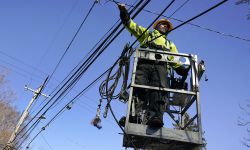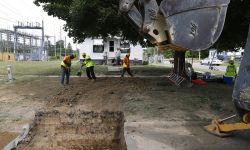Michigan student broadband internet access begins to wane post-pandemic

- Report: Pandemic gains in student broadband access waning
- Pandemic relief funds paid for hotspots, laptops, which boosted broadband access for students
- Students’ internet access is still higher than pre-pandemic levels
LANSING — Fewer Michigan students have home internet access now compared to during the COVID-19 pandemic, as federal aid for wifi hotspots and computer equipment has ended, according to a Michigan State University report released Tuesday.
In the 2020-2021 school year, 95.6 percent of Michigan students surveyed by MSU researchers had some form of home internet access. A year later, it dropped to 93.2 percent, the report said.
That is an “early warning sign” that pandemic gains in broadband access expansion in Michigan are “beginning to fade,” the report said.
The decline particularly affects rural students, who already have a harder time accessing reliable internet, the report noted. Even though school-provided hotspots boosted rural Michigan students’ access to the internet during the pandemic, one in three rural students still “lack adequate, fast, broadband home Internet,” according to the report.
The report comes two months after Gov. Gretchen Whitmer announced new funding to expand broadband access in rural Michigan. The state will receive $1.5 billion in federal infrastructure funds to deliver high-speed internet to 210,000 Michigan homes in underserved areas, with funds being distributed next year, according to the announcement.
More than 1.2 million homes in the state — roughly 31.5 percent of all Michigan households — didn’t have a fixed broadband home connection in 2021, according to a November 2021 report from the Michigan High Speed Internet Office.
Rural counties, especially ones in the Upper Peninsula, have some of the lowest broadband access in the state, according to a connectivity map by the nonprofit Connected Nation Michigan. In Luce County, for example, less than 40 percent of all households have access, the map shows.
During the COVID-19 pandemic, school-sponsored hotspots helped encourage families to get home internet access, with almost 44 percent of hotspot recipients replacing it with home internet, the Tuesday report says.
The number of rural Michigan students without home internet access decreased by 65 percent throughout the pandemic, the report noted.
But some students still lost internet access in 2022 because their families could no longer afford it.
“Parents or guardians may be unable to pay for access consistently, computing devices break and become dated and, some students — especially those who may live with parents/guardians in multiple households — can experience access insecurities,” said Keith Hampton, director of research at the MSU Quello Center, which helped conduct the study.
While school-provided hotspots are declining, the number of computer devices from schools has also decreased since students went back to in-person instructions, the report noted.
Only 40.3 percent of all students received a laptop from their school during the 2021-2022 school year, compared to 55.7 percent the year before.
Despite that, rural students have seen an increase in access to computer devices throughout the past years.
In the school year 2021-2022, 91.2 percent of rural students had access to either a laptop or a desktop computer — an increase compared to 89.2 percent in 2021 and 75.6 percent in 2019.
See what new members are saying about why they donated to Bridge Michigan:
- “In order for this information to be accurate and unbiased it must be underwritten by its readers, not by special interests.” - Larry S.
- “Not many other media sources report on the topics Bridge does.” - Susan B.
- “Your journalism is outstanding and rare these days.” - Mark S.
If you want to ensure the future of nonpartisan, nonprofit Michigan journalism, please become a member today. You, too, will be asked why you donated and maybe we'll feature your quote next time!




